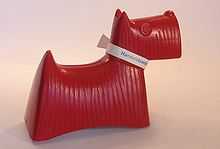Stig Lindberg




Stig Lindberg (August 17, 1916 in Umeå, Sweden–April 7, 1982 in San Felice Circeo, Italy) was a Swedish ceramic designer, glass designer, textile designer, industrial designer, painter, and illustrator.
- 1962 Gold Medal at the First International Ceramics Festival in Prague
One of Sweden's most important postwar designers, Lindberg created whimsical studio ceramics and graceful tableware lines during a long career with the Gustavsberg pottery factory. Stig Lindberg studied painting at the University College of Arts, Crafts and Design. In 1937, he went to work at Gustavsberg under Wilhelm Kåge. In 1949, he was named Kåge's successor as art director. From this period until he left Gustavsberg in 1980, he designed individual ceramic items, as well as factory produced ranges and lines of dinnerware. He achieved fame for his eccentric forms and whimsical decoration. In 1982, he died due to a myocardial infarction.
His work was featured in an exhibition, Utställning: ©Stig Lindberg (Exhibition: ©Stig Lindberg), at the Nationalmuseum in Stockholm from 11 May 2006 to 25 February 2007.
Career
- 1937–1957 and 1970–1980 Gustavsberg (art director 1949–1957, 1972–1978)
- 1947–1982 Nordiska Kompaniet, textile designer
- 1957–1970 University College of Arts, Crafts and Design, Konstfack, senior lecturer
- 1980–1982 Own studio, Italy
Awards
- 1948, 1957 Milan Triennale, gold medal
- 1951, 1954 Milan Trienalle, grand prix
- 1954 Gold Medal Art Industrial Exhibition Madrid
- 1955 Gold Medal at the First International Ceramics Festival in Cannes
- 1957 Gregor Paulsson Trophy
- 1962 Gold Medal at the First International Ceramics Festival in Prague
- 1968 Prince Eugen Medal
- 1970 honorary professorship by the Swedish Government
- 1973 Faenza, Gold Medal
Works
- The Veckla Vase (1950)
- The Reptil Vase (1950)
- The Domino Vase (1956)
See also
References
External links
| Wikimedia Commons has media related to Stig Lindberg. |
|